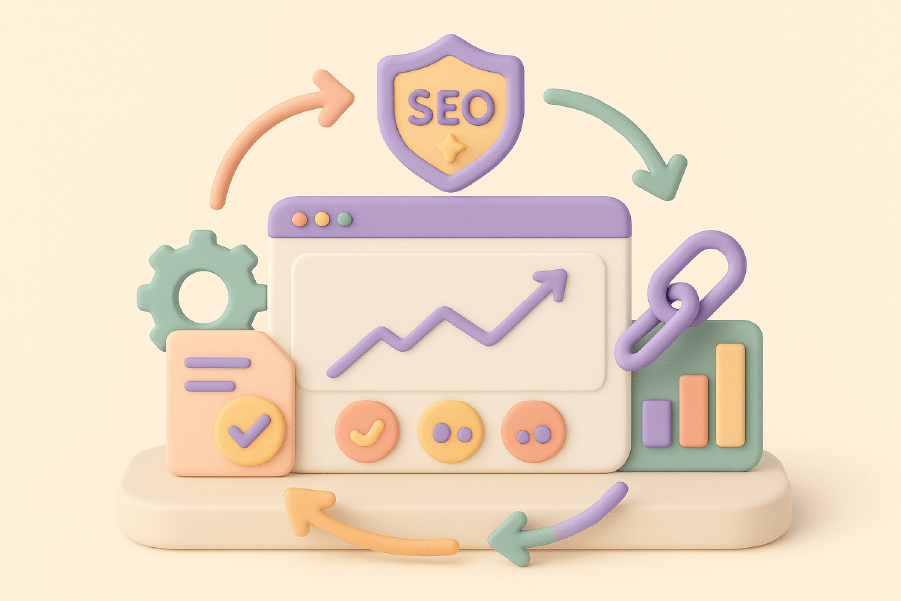Your website is the foundation of your online presence. Each page, every link, and every image work together to create an experience for your visitors and potential customers. Just like any foundation, websites can develop cracks and weaknesses over time.
A website audit is like a magnifying glass that helps you identify problems, optimize performance, and build a website that will help you achieve business success.
In today’s digital marketplace, a well-audited website does more than provide a good user experience; it enhances SEO, earns trust with your brand, and increases conversions. In this guide, we’ll walk you through the ins and outs of a website audit, what to measure, and how to use tools to ensure success.

A website audit, also known as a site audit, is a thorough examination of your website’s performance, technical health, and user experience. By taking a close look at elements like page speed, SEO, mobile-friendliness, and content quality, you’ll discover issues that might be holding you back from ranking higher, attracting more traffic, and engaging your users.
If you want your business to grow, a website audit isn’t a one-and-done task; it’s an ongoing process that reveals opportunities for improvement over time.

A website audit provides value across several areas critical to online success. Here’s what you can expect:

A fast, smooth, and intuitive website will engage your visitors and keep them coming back. Longer visits often lead to increased conversions. By identifying and fixing user experience issues, you can ensure a positive and consistent experience for your users.

SEO problems like broken links, duplicate content, and slow load times can negatively impact your search engine rankings. A thorough audit will help you find and fix these issues, giving your website a chance to rank higher.
SEO problems like broken links, duplicate content, and slow load times can negatively impact your search engine rankings. A thorough audit will help you find and fix these issues, giving your website a chance to rank higher.

By improving your website’s design, content, and navigation, you can create a user journey that gently guides visitors towards conversions. Assessing the quality and relevance of your page content is critical to its ability to help your website rank and convert.
A website audit will help you identify areas where your content is falling short. A well-structured website audit will also reveal areas where your layout, CTA placement, and functionality are hurting conversions.

A website audit also includes security vulnerabilities. Regular audits will help you identify and fix weaknesses, protecting your business and customer data from harm.
To get a complete picture of your website’s health, different types of audits focus on unique aspects. A technical website audit is essential for maintaining a well-performing website and ensuring your site is visible in search engines. Here’s a closer look:

A technical SEO audit examines elements that impact your search engine rankings like page speed, indexing, mobile-friendliness, and XML sitemaps. These technical aspects are critical to search engine crawlers’ ability to find and understand your content.

Content Audit
A content audit assesses the quality, relevance, and SEO friendliness of your website’s text, images, and videos. It ensures all your content is on-message and provides value to your visitors.

UX/UI Audit
This audit examines your website’s user experience and interface design. A UX/UI audit focuses on navigation and layout to ensure your users can find what they’re looking for without getting frustrated.

Security Audit
More and more users are accessing your website on mobile devices. A mobile-friendly website is no longer optional; it’s essential. This audit examines your website’s responsiveness and design on various screen sizes.
Before you start your website audit, it’s essential to prepare. Having the right tools and a solid checklist in place will help you move quickly and ensure you don’t miss anything.
A successful website audit relies on good tools and a solid checklist. Here are some items you need to take care about to help you get started:

Google Analytics:
You can’t optimize what you don’t measure. Google Analytics will help you track website traffic, user engagement, and conversion rates. It will give you insights into how your users are interacting with your website.

Google Search Console:
This tool helps you monitor your search engine rankings, find crawl errors, and submit your sitemaps. It’s critical for understanding how search engines are seeing your website.

Technical SEO Audit Tools:
Ahrefs, SEMrush, and Moz are just a few tools that offer technical SEO audits. They’ll help you assess your website’s structure, crawlability, and identify technical SEO issues.
They provide in-depth reports that highlight problems and opportunities for improvement.

Website Audit Checklist:
This tool helps you monitor your search engine rankings, find crawl errors, and submit your sitemaps. It’s critical for understanding how search engines are seeing your website.
Understanding the purpose behind your website audit is essential. Are you aiming to improve SEO rankings, enhance user experience, or strengthen security? Your audit goals will guide the focus of the assessment.

Google Search Console:
A free tool that helps you monitor, maintain, and troubleshoot your site’s presence in Google Search results.

Screaming Frog:
A website crawler that helps you improve onsite SEO by extracting data and auditing for common SEO issues.

GTmetrix:
Analyzes your website’s speed and provides actionable recommendations to improve performance.

Site Audit Tool:
Tools like HubSpot’s Website Grader and Semrush’s Site Audit Tool provide detailed reports on site issues and specific recommendations for improvements.
To make informed improvements, utilize tools that provide clear, actionable insights. Tools like Google PageSpeed Insights, SEMrush, and Ahrefs offer data-driven reports that simplify the auditing process.
Core Web Vitals are Google’s metrics for assessing the user experience on your site. They include:

Largest Contentful Paint (LCP):
Measures loading performance. Aim for an LCP of 2.5 seconds or faster.

First Input Delay (FID):
Measures interactivity. Aim for a delay of less than 100 milliseconds.

Cumulative Layout Shift (CLS):
Measures visual stability. A good score is below 0.1.
Key SEO areas to evaluate include:

On-Page SEO:
Titles, meta descriptions, and image alt tags should be relevant and optimized for target keywords.

Web Pages:
Ensure that each of your web pages is optimized for search engines by using robots.txt files, sitemaps, and adhering to on-page SEO best practices.

Internal Links:
Ensure there are no broken links, and that all internal links aid in navigation and SEO.

Content Quality:
Each page’s content should be relevant, engaging, and well-optimized for search engines. For further guidance, read our article, How a Technical SEO Agency Can Transform Your Website’s Performance.
Using Google’s Mobile-Friendly Test tool, confirm that your site performs seamlessly across mobile devices. Mobile compatibility not only improves user experience but is also a factor in SEO rankings.
Check for HTTPS protocol, SSL certificates, and updated plugins to ensure robust security measures are in place. Security audits should be scheduled regularly to keep potential vulnerabilities in check.

Even a well-structured audit can miss key insights if common pitfalls aren’t avoided:

With the rise of mobile browsing, overlooking mobile compatibility is detrimental to user experience and search rankings.

A great website performs well on all devices. Prioritize optimization across desktop, tablet, and mobile platforms for a cohesive user experience.

SEO results aren’t instantaneous. Regular audits and monitoring are necessary to understand the long-term impact of SEO improvements.

Page speed is often the culprit behind high bounce rates. Regularly test and optimize page loading times to keep users engaged and improve SEO performance.
Ensuring fast page speed is essential for keeping website visitors engaged and reducing bounce rates.

Once the website audit is complete, the next step is to compile a comprehensive report that summarizes your findings and provides actionable recommendations for improvement.
A well-structured audit report is essential for communicating your findings effectively. Here’s a template to guide you:

Executive Summary:
Start with a brief overview of the audit findings and key recommendations. This section should provide a snapshot of the most critical issues and suggested actions.

Introduction:
Explain the audit process and objectives. This sets the context for the report and helps stakeholders understand the purpose and scope of the audit.

Website Audit Findings:
Explain the audit process and objectives. This sets the context for the report and helps stakeholders understand the purpose and scope of the audit.

Technical SEO Issues:
Highlight problems such as broken links, crawl errors, and other technical issues.

On-Page SEO Elements:
Discuss the optimization of meta descriptions, title tags, header tags, and internal links.

User Experience:
Evaluate the design, usability, and accessibility of the site.

Recommendations:
Evaluate the design, usability, and accessibility of the site.

Technical SEO Fixes:
Specific actions to resolve technical issues.

On-Page SEO Optimization:
Steps to enhance meta descriptions, title tags, and other on-page elements.

User Experience Enhancements:
Suggestions for improving site design and usability.

Conclusion:
Summarize the audit findings and recommendations. Include a call-to-action for implementing the suggested improvements.
Present the audit report in a clear and concise manner, using visual aids such as charts, graphs, and screenshots to support your findings and recommendations. This makes the report more engaging and easier to understand.
After creating the audit report, the next crucial step is to implement the recommendations to enhance your site’s performance and achieve your desired goals.
Prioritizing the recommendations is essential to ensure that the most critical issues are addressed first. Consider the following factors when prioritizing:

Severity:
Assess the impact of each issue on the site’s performance and user experience. Address high-severity issues that significantly affect functionality or user satisfaction first.

Urgency:
Determine the need to address issues immediately to prevent further damage or loss. Urgent issues that could lead to significant problems if left unresolved should be prioritized.

Complexity:
Evaluate the difficulty of implementing each recommendation, including the resources and expertise required. Start with less complex tasks that can be quickly resolved, then move on to more complex issues.

ROI:
Consider the potential return on investment for implementing each recommendation. Focus on actions that are likely to yield significant improvements in traffic, engagement, and conversion rates.
By systematically prioritizing and implementing the recommendations, you can improve your site’s performance, increase traffic and engagement, and achieve your business goals efficiently.
After identifying and addressing major issues, there are advanced strategies to maintain ongoing success:

Structured data helps search engines understand your content better, potentially leading to enhanced listings in search results, such as rich snippets.

Regularly Update Content
Content freshness signals to search engines that your site is current and relevant. Regularly audit your content for relevance and make updates as necessary.
Conducting a social media audit can also help in evaluating content performance and enhancing audience engagement, ultimately driving more traffic to your website.

Monitor Core Web Vitals Continuously
Use Google Search Console and PageSpeed Insights to keep tabs on core metrics. Continuously monitoring these metrics ensures sustained performance improvements. You can lear more about Page Speed optimization to boost your website performance here.
Conducting a comprehensive website audit isn’t a one-time task. For sustainable growth, user retention, and improved SEO, regular audits are essential. By assessing your site’s performance, usability, and security on a regular basis, you stay ahead of competitors and offer an optimized, trustworthy experience for your audience.
A website audit done well doesn’t just enhance your digital presence; it strengthens your brand’s credibility and fosters long-term growth.
Your website deserves more than just good looks—it needs to deliver results. With LIBRA 4 humans, we design human-first solutions that elevate your digital presence and drive meaningful engagement.
Let’s turn your vision into a website that not only stands out but works hard for your business.






Reach out to LIBRA 4 humans for expert guidance on tailor made SEO solutions.
Taking the first step often requires a leap of faith, and that's why we value these 30 minutes to understand the challenges your business faces.
Please complete a few questions so we can ensure our meeting is both efficient and productive.
Talk to you soon!